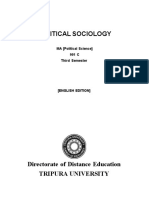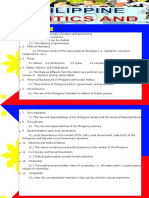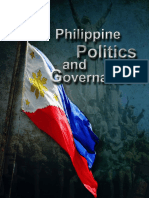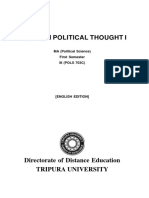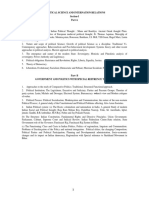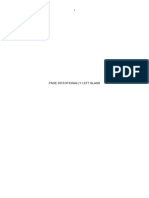Bodo PDF
Bodo PDF
Uploaded by
Bambang IrawanCopyright:
Available Formats
Bodo PDF
Bodo PDF
Uploaded by
Bambang IrawanOriginal Title
Copyright
Available Formats
Share this document
Did you find this document useful?
Is this content inappropriate?
Copyright:
Available Formats
Bodo PDF
Bodo PDF
Uploaded by
Bambang IrawanCopyright:
Available Formats
CONTENTS
PUBLIC ADMINISTRATION AND PUBLIC POLICY
Public Administration and Public Policy -
Volume 1
No. of Pages: 378
ISBN: 978-1-84826-064-1 (eBook)
ISBN: 978-1-84826-514-1 (Print Volume)
Public Administration and Public Policy -
Volume 2
No. of Pages: 424
ISBN: 978-1-84826-065-8 (eBook)
ISBN: 978-1-84826-515-8 (Print Volume)
For more information of e-book and Print
Volume(s) order, please click here
Or contact : eolssunesco@gmail.com
Encyclopedia of Life Support Systems (EOLSS)
PUBLIC ADMINISTRATION AND PUBLIC POLICY
CONTENTS
VOLUME I
Public Administration and Policy: An Introduction 1
Krishna K. Tummala, Kansas State University, Manhattan, KS, USA
1. Prologue
2. Public Policymaking and Organizational Context
3. Development of Administration: Ancient
4. Modern Systems
5. Contemporary Developments
6. Administrative Management
7. Public Policy
8. Epilogue
Social Diversity and Development Policy: The Use of Constraints and Incentives 22
Aruna Nayyar Michie, Department of Political Science, Kansas State University, Manhattan, Kansas,
USA
1. Introduction
2. Goals and Requirements of Development
3. Society and Polity
4. State Intervention and Development
5. A Proposal for Effective Decision making
6. Conclusion
Political Parties: Principal Arenas of Policymaking Conflict 41
Ralph M. Goldman, Professor Emeritus of Political Science, San Francisco State University, USA
Former President, Center for Party Development, Catholic University of America, USA
1. Introduction
2. A Brief Institutional History of Parties
3. Types of Party System and their Policymaking Consequences
4. Party Functions and External Relationships
4.1. Parties and Elections
4.2. Parties in the Legislature
4.3. Parties and the Chief Executive
4.4. Partisanship in the Judiciary
4.5. Parties and Organized Interest Groups
4.6. Parties and the Media
5. Factionalism and the Nominating Process
5.1. Coalition Formation and Moderation
5.2. First Elections
5.3. Popular Participation in Nominations
6. Political Parties as Planning Agencies and Policy Advocates
7. Cases of Political Parties Impact on Life-Support Policies
7.1. Personal Safety in Colombia
7.2. Water in India
7.3. Death and Life in Russia
8. Future Development of Political Parties
9. Rights and Responsibilities of Political Parties
Public Administration in Today's World of Organizations and Markets 64
Hebert A. Simon(Deceased), Carnegie Mellon University, USA
Encyclopedia of Life Support Systems (EOLSS) i
PUBLIC ADMINISTRATION AND PUBLIC POLICY
1. Research on Complex Organizations
2. Markets as Coordinating Mechanisms
3. From a Market Economy to an Organizational Economy
4. How Organizations Coordinate
5. Organizational Identification
6. Organizational Innovation and Adaptation to Change
7. Social Implications
7.1. The Distribution of Power
7.2. Distribution of the Social Product: Levels of Employment and Production
7.3. Distribution of the Social Product: Fairness
8. Conclusion
Planned Organizational Change: Essentials for Constructive Action 76
Garth N. Jones, University of Alaska, Anchorage, USA
1. Context
2. Organizations: delineations and specifics
3. Context of change intervention
4. Change components and their dynamic relationships
4.1. Assessing the Social-Technical System(s)
4.1.1. Change myth and doctrine
4.1.2. Change goals
4.1.3. Organizations and operational domains
4.1.4. Structuring of change
4.1.5. Application of strategies and tactics
4.1.6. Evaluation of the endeavor
Organizational Culture: Understanding Theoretical and Practical Applications 92
Suzanne Marie Leland, Department of Political Science, University of North Carolina at Charlotte, USA
1. Introduction
2. Early History and Recent Development of the Study of Organizational Culture
3. Modern Organizational Culture in Public Agencies
4. Deciphering an Organizations Culture
5. Conclusion: Culture, Leadership and Change
Persian Legacies of Bureaucracy and Public Administration 98
Ali Farazmand, Florida Atlantic University, USA
1. Introduction
2. Early Iran, prior to the Persian Empire
3. The World-State Persian Empire
3.1. The founding father, Cyrus the Great
3.2. Institutions of governance
3.2.1. The King and the central government
3.2.2. The satrapy system of administration
3.2.3. The Persian bureaucracy
4. Administrative Reforms of Darius
5. Persian Legacies towards Administration
Development of African Administration: Pre-Colonial Times and since 113
Kisangani F. Emizet, Kansas State University, Manhattan, Kansas, USA
1. The Pre-colonial Period: From the Ashes of Pharaohs to the Berlin Conference
Encyclopedia of Life Support Systems (EOLSS) ii
PUBLIC ADMINISTRATION AND PUBLIC POLICY
1.1. Ancient Civilization of Africa: The Case of Egypt
1.2. Medieval Africa
1.3. Beyond the Medieval Era to the Nineteenth Century
2. Colonial Administration
2.1. The Consolidation of the Colonial Administration
2.2. Beyond the First World War and toward Independence
3. The Post-Colonial Administration and Problems of Development
3.1. Historical and Structural Origins
3.2. Administrative Performance in the Post-Colonial Period
3.3. Administrative Reforms in Africa
4. Conclusions
Politics in the Ancient Near East 135
Yves Schemeil, Institute dEtudes Politiques de Grenoble, France
1. Introduction
2. Ruling and Abiding by the Rules
2.1. Early Components of a Public Culture
2.2. Good Governance and the Art of Ruling
3. Representative Systems
3.1. Political Representation and the Deliberative Process
3.2. Voting and the Electoral Process
3.3. Social Justice and the Judiciary
4. Conclusion
Ancient Bureaucracies of India and China, and Modern Administration 147
V. Subramaniam, Carleton University, Ottawa, Canada
1. Western Misinterpretations
1.1. Max Weber's Prebendal Bureaucracy
1.2. Karl Marx's Asiatic Mode of Production
1.3. Eisenstadt's Bureaucratic Empires
2. Comparisons: India and China
3. Indian and Chinese Evolution: Critical Comparisons
4. Confucian Brahmins and Kautilyan Mandarins
5. The European Evolution
5.1. The Roman Empire
5.2. Feudalism and the Catholic Church
5.3. Societal Evolution: Facilitating Factors
6. Some Lessons from Comparative Survey
6.1. The District Collector
6.2. Societal Evolution and State Enterprises
6.3. The Derivative Middle Class
French Public Administration 165
John A. Rohr, Virginia Polytechnic Institute, Blacksburgh, U.S.A
1. Introduction
2. History of French Administration
3. The Constitution of the Fifth Republic
4. The Role of State in French political Culture
5. The Civil Service
6. The Grands Corps of the State
7. Relation of Administration to the Private Sector
8. Decentralization and the Prefects
Encyclopedia of Life Support Systems (EOLSS) iii
PUBLIC ADMINISTRATION AND PUBLIC POLICY
9. Administrative Law
10. Conclusion
Public Administration in America: The Exceptionalism of a Hybrid Bureaucracy 183
Fred W. Riggs, Political Science Department, University of Hawaii, USA
1. Introduction
2. Attractions of Presidentialism
3. The American Exception
3.1. Making valid comparisons
3.2. Power and performance
4. Types of Bureaucracy
4.1. Mandarins
4.2. Retainers
4.3. In-and-Outers
4.4. Functionists
5. Mandarinates
6. Presidentialism and the US
6.1. Patronage and Spoils
7. A hybrid bureaucracy
7.1. Rotation and Spoils
7.2. Teaching Public Administration
7.3. Professionalism
8. Conclusion
Politics and Anti-Politics: American Public Administration in the Nineteenth Century 199
Nicholas Henry, Georgia Southern University, USA
1. Introduction
2. Stunted and Truncated: Public Administration of the Nineteenth Century
2.1. A Stunted Government
2.2. A Truncated Profession
3. A Gentlemanly but Political Public Service
3.1. Dark Tides: Populism and Patronage
4. Jackson and Democratization
4.1. From Democratization to Spoils
5. Reform: Honesty and Anti-Politics
5.1. Early Efforts
5.2. Reform by Murder
6. Nirvana Attained: The Civil Service Act of 1883
7. The Merit Principle and American Governments
8. Reform: The Foundation for the Next Century
New Public Management: Origins, Dimensions and Critical Implications 209
M. Shamsul Haque, National University of Singapore, Singapore
1. Introduction
2. Origin and Globalization of New Public Management
3. Rationales and Causes of New Public Management
4. Major Dimensions of New Public Management
4.1. Theoretical-Conceptual Dimension
4.2. Functional-Professional Dimension
4.3. Structural-Compositional Dimension
4.4. Normative-Ethical Dimension
4.5. Strategic-Technical Dimension
Encyclopedia of Life Support Systems (EOLSS) iv
PUBLIC ADMINISTRATION AND PUBLIC POLICY
5. Critical Implications of New Public Management
5.1. Implications for Citizens
5.2. Implications for public service
6. Limits and Prospects of New Public Management
Strategies of Successful Administrative Reforms 229
V. Bhaskara Rao, Kakatiya University, Warangal, India
1. Introduction
2. Administrative reforms
3. Politics of reform
4. Characteristics of reforms
5. Approaches to reforms
5.1. Citizens charter
5.2. Re-engineering the government
5.3. Re-inventing government
5.4. New public management (NPM)
5.5. Privatization/contracting out
6. Financial reform
7. Democratization
8. Decentralization
9. The Indian experience
10. Evaluation of reforms
Reforms in the Public Administration Systems in New Zealand 246
Peter McKinlay, McKinlay Douglas Limited, Wellington, New Zealand
1. Introduction
2. Context
3. Political Factors
4. Intellectual Framework
5. The Principal Reforms
5.1. Trading activities
5.2. Restructuring the Core Public Service
5.3. Financial Management
6. Overview and Assessment
6.1. Outcome Accountability
6.2. Policy Advice
6.3. The "Collective Interest of Government"
6.4. Departmental Capability
7. Subsequent Developments
Governance, Facilitative States and Twenty-First Century Public Administration 263
C. A. Newland, University of Southern California, USA
1. Introduction
2. Governance and Facilitative Institutions
2.1. Three Dimensions of Governance as a Global Framework
2.1.1. Social Self Governance and Civil Society
2.1.2. Economic Governance and Markets
2.1.3. The Facilitative State and Political Governance
2.2. Applied Pluralist and Public-Choice Theories and Todays Search for Good Governance
2.2.1. Reconciliation via Governance and Facilitative State Perspectives
2.2.2. Searching Questions and Connectedness
3. Varied and Shared Public Administration Frameworks Within and Among Nations
Encyclopedia of Life Support Systems (EOLSS) v
PUBLIC ADMINISTRATION AND PUBLIC POLICY
3.1. Continental European Thought and Practices
3.1.1. Public-Sector Redefinition
3.1.2. Deconcentration: Dispersed Authority and Responsibilities
3.1.3. Balancing Transparency and Access with Privacy and Security
3.1.4. Government under Law and Governance through Law
3.1.5. Accountability and Responsibility
3.2. New Public Management, Commonwealth Nations, and Related Developments
3.2.1. Post-Bureaucratic Theories and Practices?
3.2.2. Responsive, High-Performance Administrative Cultures
3.2.3. Public Entrepreneurship and Managerial Autonomy
3.2.4. Competition and Private Performance of Publicly Provided Functions
3.2.5. Matching Resources and Functions Performed
3.2.6. Contexts and Theories Underlying NPM
3.3. Shared and Varied American Frameworks
3.3.1. Enduring Civic-Constitutional Ideals and Public Administration
3.3.2. Failed Autonomy of American Public Administration
3.3.3. Complexities of Contemporary Movements
4. International Perspectives and Shared Paradoxes of Public Administration
4.1. Situational Differences and Shared Practices as Twenty-First Century Realities
4.2. The United Nations and World Bank
4.3. Enduring and Twenty-First Century Paradoxes of Governance in a Facilitative-State Era
The Internet, Governments and the Issue of Governance: A New Cartography of Power? 293
Loong Wong, University of Newcastle, New South Wales, Australia
1. Introduction
2. Towards a New Globalized Economy : A New Architecture
3. The Death of Space?
4. Sovereignty, Electronic Commerce and Globalization
5. Developing a New Global Framework for Electronic Commerce
6. Redefining the Role of Governments
7. Conclusion
Index 311
About EOLSS 319
VOLUME II
Contemporary Public Human Resource Management Systems: Patronage, Civil Service,
Privatization, and Service Contracts 1
Donald E. Klingner, Florida International University, Miami, FL, USA
Mohamed Gamal Sabet, Agricultural Economics Research Institute, Cairo, Egypt
1. Introduction
2. Public Personnel Management Functions
3. Public Jobs as Scarce Resources
4. Traditional Values
5. Emergent Values
6. Traditional Systems: Patronage, Civil Service, Collective Bargaining, and Affirmative Action
7. Emergent Systems
8. Conflict and Compromise among Alternative Public Personnel Systems
8.1. A Historical Analysis of Public Personnel System Conflict in the United States
8.2. Historical Analysis of Public Personnel System Conflict in Less Developed Countries
Encyclopedia of Life Support Systems (EOLSS) vi
PUBLIC ADMINISTRATION AND PUBLIC POLICY
9. Service Contracting and Privatization Outcomes in Developed and Less developed Countries
Revisiting Budgetary Incrementalism 23
Zahid Shariff, The Evergreen State College, Olympia, WA, USA
1. Introduction
2. Basic Issues
2.1. Larger connections
2.2. Some distinctions
2.3. Characteristics of budgeting
3. The Demise of Incrementalism
4. Broader Context, Limited Horizon
4.1. Gentlemanly government
4.2. Denouncing reform
4.3. Either/or
5. Contradictions: Holding on and Letting go
5.1. Rejecting and accepting
5.2. More inconsistencies
5.3. Policy and counseling
6. Encountering Change
6.1. Reducing and increasing conflict
6.2. Governmental (in)capacity
6.3. Imbalanced perspective
6.4. Sympathy and inaction
7. Return to Basics
7.1. Theoretical building blocks
7.2. Different kinds of incrementalism
8. Conclusions
Budgeting for Government Activism and Democracy 35
Irene S. Rubin, Northern Illinois University, De Kalb, IL, USA
1. The Need for Budget Reforms
2. Designing a Budget Reform
3. Budgeting for Government Activism
4. Budgeting for Democracy
4.1. The Budget Hearing
4.2. Citizen Planning and Prioritizing
5. Conclusion
Financial Management and Life Support Programs 48
A.. Premchand, Formerly, Assistant Director, Fiscal Affairs Department, International Monetary fund,
India.
1. Introduction
2. Scope of Life Support Programs
3. Differences between Industrial and Developing Countries
4. Financial Management Cycle
5. Issues in Practice
5.1. Policy Management
5.2. Segmented and Integrated Approaches
5.3. Intent and Outcome
5.4. The Anchor of Expenditure Management
5.5. Delivery of Services
5.6. Fraud and Waste
Encyclopedia of Life Support Systems (EOLSS) vii
PUBLIC ADMINISTRATION AND PUBLIC POLICY
5.7. Neglected Fault Lines Transparency and Accountability
6. Tasks Ahead
Elusive Nexus: Basic Needs and Fiscal Decentralization 64
Kurt Thurmaier, Iowa State University, Ames, IA, USA
Kara Lindaman, University of Kansas, Lawrence, KS, USA
1. Introduction
2. A Brief History
3. Participation in Development
3.1. The Theories of Basic Needs and Decentralization
3.2. Basic Needs
3.3. Decentralization
3.4. The Nexus
4. Previous Empirical Work
5. An Empirical Test of the Common Ground
5.1. The Model
5.2. Dependent Variable: The Human Development Index
5.3. Independent Variables
5.4. Control Variables
5.5. Final Model Equation
5.6. The Data: Caveats
6. The Results
6.1. The Basic Needs Indices and Decentralization
6.2. The Colonial History Control Variables
7. Conclusions
Measuring Performance in Public Sector Programs 86
Gerald E. Caiden, University of Southern California, Los Angeles, USA
Naomi J. Caiden, California State University, Los Angeles, USA
1. Introduction
2. Significance
3. The State of the Art
4. Implementation
5. Limitations
6. Institutional Context
7. The Bottom Line
Administrative Law 110
David H. Rosenbloom, Department of Public Administration and Policy, American University, USA
1. Introduction
2. Administrative Power, Discretion, and the Rule of Law
3. Administrative Rulemaking
3.1. How much independence should administrative agencies have in developing and issuing rules?
3.2. What values should be emphasized in rulemaking procedures?
3.3. By what criteria should rules be judged?
3.4. What Are Some Common Types Of Rulemaking?
4. Administrative Adjudication
5. Enforcement
6. Transparency
7. The Legal Status of Public Agencies and Administrators
8. External Review of Agency Operations
8.1. Substantive Review of Administrative Decisions
Encyclopedia of Life Support Systems (EOLSS) viii
PUBLIC ADMINISTRATION AND PUBLIC POLICY
8.2. Procedural Review of Agency Actions
9. Conclusion
The Ombudsman Office 133
S. E. Aufrecht, University of Alaska Anchorage, Anchorage, AK, USA
1. Introduction
2. The Historical Creation of Ombudsman Offices
3. What is an Ombudsman?
3.1. The mission of the ombudsman
3.2. What is a classical ombudsman?
3.2.1. Independence from those being investigated
3.2.2. Impartiality and Fairness
3.2.3. Credible Review Process
3.2.4. Confidentiality
3.3. The International Ombudsman Institute
4. The Current State of the Ombudsman Concept
5. The Ombudsman Office in the Context of other Correction Mechanisms
5.1. The Specifics of the Ombudsmans Job
5.2. Ombudsman Office Compared to Other Avenues for Remedy
6. The Effectiveness of the Ombudsman
7. Conclusion
Ethics in Public Organizations 145
Kathryn G. Denhardt, University of Delaware, USA
1. Introduction
2. Ethics at the Institutional Level
3. Ethics at the Organizational Level
3.1. Prevention, Investigation, and Prosecution
3.2. Leadership and Organizational Culture
4. Ethics at the Individual Public Servant Level
5. Conclusion
Technology Transfer and Diffusion 156
Kenneth L. Nichols, University of Maine, USA
1. The Beginnings of Technology Dissemination
1.1. Technology: Multiple Definitions
1.1.1. Languages and Codes
1.1.2. Customs, Traditions, Rituals, and Rites
1.1.3. Applied Concepts and Knowledge
1.1.4. Manufactured Goods and Tools
1.1.5. Natural Objects Adapted for Use
1.1.6. Aesthetic Objects and Performances
1.2. Impact on Societies
1.2.1. Level of Impact
1.2.2. Nature of Consequences
2. The Process of Technology Dissemination
2.1. Stages in Technology Dissemination
2.1.1. Stage 1: Innovation
2.1.2. Stage 2: Communication
2.1.3. Stage 3: Adoption
2.2. Technology Dissemination depends upon People, Things, and Places
2.2.1. People: The Actors and their Roles
Encyclopedia of Life Support Systems (EOLSS) ix
PUBLIC ADMINISTRATION AND PUBLIC POLICY
2.2.2. Things: The Donors Technology and the Recipients Need
2.2.3. Places: The Settings across Times and Localities
3. Policy and Practice in Technology Dissemination
3.1. Purposes and Formal Organizations
3.2. Factors Affecting Policies and Practices
3.2.1. Cultures
3.2.2. Resources
3.2.3. Relationships
4. Technology Dissemination: Prospects and Ramifications
4.1. Development Cycle
4.2. The Pace of Dissemination
4.3. Bottom-line Ramification
International Environmental Policy as a Life Support System Response 175
Renu Khator, University of South Florida, USA
1. Environmental Policy Challenges in the Twenty-First Century
1.1. Global Capitalism versus Individual Economies
1.2. Northern Consumption versus Southern Population
1.3. Environmental Security versus Diplomatic Security
1.4. Political Sovereignty versus Global Public Sphere
1.5. Individual Accountability versus Global Responsibilities
1.6. Anthropocentric Values versus Environmental Ethics
2. Environmental Policy as a Response System
2.1. Environmental Ethics as the Foundation
2.2. Global Responsibility as the Principle
2.3. Local Decision-making as the System of Governance
2.4. Quality of Life as the Goal
3. Concluding Remarks
Developmental Issues and Environmental Policy in South Africa 190
Ignatius W. Ferreira, Port Elizabeth Technikon, South Africa
H. R. Lloyd, Vista University, Port Elizabeth, South Africa
1. Introduction
2. The South African Context
3. Growth, Development and the Environment
4. Sustainable Development
5. Natural Resource Economics Policy in South Africa
5.1. Integrated pollution and waste management
5.2. Linkages with macro-economic policy
5.3. Approaches to integrated pollution and waste management
5.4. Operation of environmental management policy
6. The Environment as an Asset
7. The Design of Environmental Policy
8. Environmental Management as an Integral Part of Business Strategy
9. Conclusion
Corruption in Asian Countries: Can It Be Minimized? 201
Jon S. T. Quah, National University of Singapore, Singapore
1. Levels of Asian Corruption
1.1. Measuring corruption
2. Anti-Corruption Strategies
2.1. Hopeless strategies
Encyclopedia of Life Support Systems (EOLSS) x
PUBLIC ADMINISTRATION AND PUBLIC POLICY
2.1.1. Peoples Republic of China
2.1.2. Indonesia
2.1.3. Bangladesh
2.2. Ineffective strategies
2.2.1. The Philippines
2.2.2. South Korea
2.2.3. Thailand
2.3. Effective Strategy
3. Lessons from Singapore
3.1. Reducing opportunities for corruption
3.2. Reducing incentives for corruption
Politics of Preference: Lessons from India, The United States and South Africa 218
Krishna K. Tummala, Kansas State University, Manhattan, KS, USA
1. Introduction
2. The Case for and against AA
3. Policy Initiatives
4. Politics of Preference
5. An Assessment
6. Conclusion
The Role of Business and Industry 233
Hazel Henderson, St. Augustine, Florida, USA
1. Introduction
2. Historical Background
3. Evolution of Corporate Charters and Stock Markets
4. Globalization of Corporations, Technology, Markets, and Finance
5. Rethinking Capitalism beyond Textbook Models of the Public and Private Sectors
6. Changing Scorecards of Progress
6.1. Employment
6.2. Income
6.3. Shelter
6.4. Infrastructure
6.5. Energy
6.6. National Security
6.7. Health
6.8. Education
6.9. Public Safety
6.10. Human Rights
6.11. Environment
6.12. Re-creation
7. The Third Sector: Voluntary Civic Society Organizations Challenging Businesses on Life Support
Issues
8. New Business Models of Capitalism
9. Toward "Stakeholder Capitalism"
10. The Role of Corporations in Voluntary Standard Setting and Codes of Conduct
11. Obligations of Corporations and Business to Enhance Life Support Systems
12. Conclusion
Sustainable Development:The Role of Business 276
J. Aloisi de Larderel, Director, Division of Technology, Industry and Economics, United Nations
Environment Programme, France
Encyclopedia of Life Support Systems (EOLSS) xi
PUBLIC ADMINISTRATION AND PUBLIC POLICY
1. Introduction: Why Is the Role of Business So Important for Sustainable Development?
2. Why Is It in a Business Interest to be Environmentally Sustainable?
3. What Is the Role of Business for Sustainable Development?
3.1. Goals
3.2. Strategy
3.3. Practical Measures
4. Conclusions
Institutional Dimensions of Global Environmental Change 297
Oran R. Young, Institute on International Environmental Governance, Dartmouth College, USA
1. Institutions and Environmental Change
2. The Nature and Role of Institutions
3. The Research Agenda
3.1. Causation
3.2. Effectiveness
3.3. Design
4. Models and Methods
5. Future Directions
New Principles of Governance in the Global Age 314
A. V. Anttiroiko, Department of Local Government Studies, University of Tampere, Finland
1. Introduction
2. Remarks on the Trends in Power Politics
2.1. From the Westphalian Model to the Post-Cold War World
2.2. Human Rights and Sovereignty of the State
3. Institutional Aspects of Global Governance
3.1. New Premises of Global Governance
3.2. The United Nations and International Peace
3.3. International Organizations and Agreements
3.4. International Conferences
3.5. The Dilemma of Accountability
4. Corporate Agenda
4.1. Towards the Global Free Market Policy
4.2. The Power of Multinationals
5. Changing Role of the Nation-state
5.1. External Pressures on the State
5.2. Intra-State Tensions and State Capacity
6. Regional Institutions and Local Governance
6.1. Aspects of Regionalization
6.2. Formation of Macroregional Institutions
6.3. Global Orientation in Urban Governance
6.4. Expressions of Regionalism and Localism
6.5. Networking and Partnership as Working Methods
6.6. Social Balance and Sustainable Development
7. Civil Society and NGOs
7.1. The Concept of Civil Society
7.2. Civil Society and the Principles of Good Governance
7.3. Identity and Citizenship
8. Future Directions
8.1. Problems, Threats and Risks
8.2. The Need for Multi-Level Governance
Encyclopedia of Life Support Systems (EOLSS) xii
PUBLIC ADMINISTRATION AND PUBLIC POLICY
Corporate Social Responsibility:Managing and Minimizing the Abuse of Power 345
Bruce Lloyd, Professor of Strategic Management, South Bank University, London, UK
1. Introduction
2. Core Principles
3. Innovation and Change
4. Stakeholder Management
5. Social Auditing
6. New Partnerships
7. Leadership
8. Power and Responsibility
9. Educational Challenges
Index 361
About EOLSS 367
Encyclopedia of Life Support Systems (EOLSS) xiii
You might also like
- The Matrix of Race - Social Construction, Intersectionality, and Inequality, 1st Edition - Rodney D. Coates & Abby L. Ferber & David L. Brunsma50% (4)The Matrix of Race - Social Construction, Intersectionality, and Inequality, 1st Edition - Rodney D. Coates & Abby L. Ferber & David L. Brunsma817 pages
- (Barber, B. R.) Strong Democracy Participatory Po100% (11)(Barber, B. R.) Strong Democracy Participatory Po357 pages
- Regulating The Undead in A Liberal World Order: Free-Rider Problem, As The Payoff Structure inNo ratings yetRegulating The Undead in A Liberal World Order: Free-Rider Problem, As The Payoff Structure in10 pages
- Theorizing Foreign Policy in A Globalized World by Gunther Hellmann, Knud Erik Jørgensen (Eds.)100% (2)Theorizing Foreign Policy in A Globalized World by Gunther Hellmann, Knud Erik Jørgensen (Eds.)265 pages
- First Semester Number of Hours - 60 Credits-3 Objective of The Course ContentNo ratings yetFirst Semester Number of Hours - 60 Credits-3 Objective of The Course Content3 pages
- Wassce / Waec Civic Education Syllabus: You Ace The WASSCE in Flying ColoursNo ratings yetWassce / Waec Civic Education Syllabus: You Ace The WASSCE in Flying Colours8 pages
- Politics and Governance Workbook For Grade 12 Shs100% (3)Politics and Governance Workbook For Grade 12 Shs169 pages
- Democracy and Civil Society in Asia: Jayant Lele and Fahimul QuadirNo ratings yetDemocracy and Civil Society in Asia: Jayant Lele and Fahimul Quadir240 pages
- College of Agricultural Technology FIRST SEMESTER SY 2019-2020No ratings yetCollege of Agricultural Technology FIRST SEMESTER SY 2019-20205 pages
- Syllabus - Political Sociology - MAPol Science - 901C English - 21072017No ratings yetSyllabus - Political Sociology - MAPol Science - 901C English - 21072017188 pages
- Betty A. Dobratz, Lisa K. Waldner, Timothy Buzzell - Power, Politics, and Society - An Introduction To Political Sociology-Routledge (2019)100% (1)Betty A. Dobratz, Lisa K. Waldner, Timothy Buzzell - Power, Politics, and Society - An Introduction To Political Sociology-Routledge (2019)875 pages
- Good Democratic Leadership On Prudence and Judgment in Modern Democracies First Edition. Edition Kane All Chapters Instant Download100% (3)Good Democratic Leadership On Prudence and Judgment in Modern Democracies First Edition. Edition Kane All Chapters Instant Download52 pages
- Party and Professionals 1st Edition Gordon White Ebook All Chapters PDF100% (2)Party and Professionals 1st Edition Gordon White Ebook All Chapters PDF69 pages
- Philippine Politics and Governance - AY 2020 - 2021No ratings yetPhilippine Politics and Governance - AY 2020 - 2021129 pages
- PSIR Paper 2 Part A Comparative PoliticsNo ratings yetPSIR Paper 2 Part A Comparative Politics18 pages
- Polarization and the Politics of Personal Responsibility 1st Edition Mark D. Brewer 2024 scribd download100% (2)Polarization and the Politics of Personal Responsibility 1st Edition Mark D. Brewer 2024 scribd download71 pages
- Comparative Politics: MA (Political Science) Second Semester POLS 802CNo ratings yetComparative Politics: MA (Political Science) Second Semester POLS 802C324 pages
- Global Politics: Exploring Diverse Systems and Ideologies: Understanding Political Systems, Ideologies, and Global Actors: Global Perspectives: Exploring World Politics, #1From EverandGlobal Politics: Exploring Diverse Systems and Ideologies: Understanding Political Systems, Ideologies, and Global Actors: Global Perspectives: Exploring World Politics, #1No ratings yet
- Democratic life after the transition: in search of governability in Brazil: from Sarney to Lula's first presidencyFrom EverandDemocratic life after the transition: in search of governability in Brazil: from Sarney to Lula's first presidencyNo ratings yet
- Sem-I Political Science - Major & Minor - PDFNo ratings yetSem-I Political Science - Major & Minor - PDF2 pages
- COMPARATIVE-GOVERNMENT-AND-POLITICS-PRELIM-MODULENo ratings yetCOMPARATIVE-GOVERNMENT-AND-POLITICS-PRELIM-MODULE36 pages
- The_Tianxia_System_A_Transcendence_to_the_Liberal_No ratings yetThe_Tianxia_System_A_Transcendence_to_the_Liberal_14 pages
- (Ebook) Polarization and the Politics of Personal Responsibility by Mark D. Brewer, Jeffrey M. Stonecash ISBN 9780190239817, 9780190239824, 0190239816, 0190239824 All Chapters Instant Download100% (3)(Ebook) Polarization and the Politics of Personal Responsibility by Mark D. Brewer, Jeffrey M. Stonecash ISBN 9780190239817, 9780190239824, 0190239816, 0190239824 All Chapters Instant Download65 pages
- Democracy and Civil Society in Asia: Volume 1: Fahimul Quadir and Jayant LeleNo ratings yetDemocracy and Civil Society in Asia: Volume 1: Fahimul Quadir and Jayant Lele252 pages
- Western Political Thought From Plato To MarxNo ratings yetWestern Political Thought From Plato To Marx2 pages
- Rise of Illiberalism in South Asia - Shahzad InayatNo ratings yetRise of Illiberalism in South Asia - Shahzad Inayat46 pages
- Comparing Public Bureaucracies: Problems of Theory and MethodFrom EverandComparing Public Bureaucracies: Problems of Theory and MethodNo ratings yet
- Syllabus For POS 592: American Political InstitutionsNo ratings yetSyllabus For POS 592: American Political Institutions6 pages
- Daniel Deudney - The Great Descent, Global Governance' in Historical and Theoretical PerspectiveNo ratings yetDaniel Deudney - The Great Descent, Global Governance' in Historical and Theoretical Perspective24 pages
- Icusta Intl English Version Course CompilationNo ratings yetIcusta Intl English Version Course Compilation76 pages
- Performance Management in International OrganizationsNo ratings yetPerformance Management in International Organizations244 pages
- The United Nations and Contemporary Global Governance100% (1)The United Nations and Contemporary Global Governance17 pages
- Prelim Coverage - Chapter 1: The Study of GlobalizationNo ratings yetPrelim Coverage - Chapter 1: The Study of Globalization20 pages
- UNIT 2 Structure of Globalization - Module Contemporary WorldNo ratings yetUNIT 2 Structure of Globalization - Module Contemporary World39 pages
- George Sorensen - What Kind of World OrderNo ratings yetGeorge Sorensen - What Kind of World Order28 pages
- Oas Community College: Republic of The Philippines Commission On Higher Education Oas, AlbayNo ratings yetOas Community College: Republic of The Philippines Commission On Higher Education Oas, Albay22 pages
- 5 GE 3 Structures of Globalization The Global Interstate System PDF100% (2)5 GE 3 Structures of Globalization The Global Interstate System PDF5 pages
- Understanding Global Politics and Diplomacy Within The International Relations ContextNo ratings yetUnderstanding Global Politics and Diplomacy Within The International Relations Context19 pages
- Global Governance in The 21st Century GilbertNo ratings yetGlobal Governance in The 21st Century Gilbert5 pages
- Global Civil Society Is Seen As The Backlash' To BothNo ratings yetGlobal Civil Society Is Seen As The Backlash' To Both5 pages
- The Matrix of Race - Social Construction, Intersectionality, and Inequality, 1st Edition - Rodney D. Coates & Abby L. Ferber & David L. BrunsmaThe Matrix of Race - Social Construction, Intersectionality, and Inequality, 1st Edition - Rodney D. Coates & Abby L. Ferber & David L. Brunsma
- Regulating The Undead in A Liberal World Order: Free-Rider Problem, As The Payoff Structure inRegulating The Undead in A Liberal World Order: Free-Rider Problem, As The Payoff Structure in
- Theorizing Foreign Policy in A Globalized World by Gunther Hellmann, Knud Erik Jørgensen (Eds.)Theorizing Foreign Policy in A Globalized World by Gunther Hellmann, Knud Erik Jørgensen (Eds.)
- First Semester Number of Hours - 60 Credits-3 Objective of The Course ContentFirst Semester Number of Hours - 60 Credits-3 Objective of The Course Content
- Wassce / Waec Civic Education Syllabus: You Ace The WASSCE in Flying ColoursWassce / Waec Civic Education Syllabus: You Ace The WASSCE in Flying Colours
- Democracy and Civil Society in Asia: Jayant Lele and Fahimul QuadirDemocracy and Civil Society in Asia: Jayant Lele and Fahimul Quadir
- College of Agricultural Technology FIRST SEMESTER SY 2019-2020College of Agricultural Technology FIRST SEMESTER SY 2019-2020
- Syllabus - Political Sociology - MAPol Science - 901C English - 21072017Syllabus - Political Sociology - MAPol Science - 901C English - 21072017
- Betty A. Dobratz, Lisa K. Waldner, Timothy Buzzell - Power, Politics, and Society - An Introduction To Political Sociology-Routledge (2019)Betty A. Dobratz, Lisa K. Waldner, Timothy Buzzell - Power, Politics, and Society - An Introduction To Political Sociology-Routledge (2019)
- Good Democratic Leadership On Prudence and Judgment in Modern Democracies First Edition. Edition Kane All Chapters Instant DownloadGood Democratic Leadership On Prudence and Judgment in Modern Democracies First Edition. Edition Kane All Chapters Instant Download
- Party and Professionals 1st Edition Gordon White Ebook All Chapters PDFParty and Professionals 1st Edition Gordon White Ebook All Chapters PDF
- Philippine Politics and Governance - AY 2020 - 2021Philippine Politics and Governance - AY 2020 - 2021
- Polarization and the Politics of Personal Responsibility 1st Edition Mark D. Brewer 2024 scribd downloadPolarization and the Politics of Personal Responsibility 1st Edition Mark D. Brewer 2024 scribd download
- Comparative Politics: MA (Political Science) Second Semester POLS 802CComparative Politics: MA (Political Science) Second Semester POLS 802C
- Global Politics: Exploring Diverse Systems and Ideologies: Understanding Political Systems, Ideologies, and Global Actors: Global Perspectives: Exploring World Politics, #1From EverandGlobal Politics: Exploring Diverse Systems and Ideologies: Understanding Political Systems, Ideologies, and Global Actors: Global Perspectives: Exploring World Politics, #1
- Democratic life after the transition: in search of governability in Brazil: from Sarney to Lula's first presidencyFrom EverandDemocratic life after the transition: in search of governability in Brazil: from Sarney to Lula's first presidency
- The_Tianxia_System_A_Transcendence_to_the_Liberal_The_Tianxia_System_A_Transcendence_to_the_Liberal_
- (Ebook) Polarization and the Politics of Personal Responsibility by Mark D. Brewer, Jeffrey M. Stonecash ISBN 9780190239817, 9780190239824, 0190239816, 0190239824 All Chapters Instant Download(Ebook) Polarization and the Politics of Personal Responsibility by Mark D. Brewer, Jeffrey M. Stonecash ISBN 9780190239817, 9780190239824, 0190239816, 0190239824 All Chapters Instant Download
- Democracy and Civil Society in Asia: Volume 1: Fahimul Quadir and Jayant LeleDemocracy and Civil Society in Asia: Volume 1: Fahimul Quadir and Jayant Lele
- Rise of Illiberalism in South Asia - Shahzad InayatRise of Illiberalism in South Asia - Shahzad Inayat
- Comparing Public Bureaucracies: Problems of Theory and MethodFrom EverandComparing Public Bureaucracies: Problems of Theory and Method
- Syllabus For POS 592: American Political InstitutionsSyllabus For POS 592: American Political Institutions
- Daniel Deudney - The Great Descent, Global Governance' in Historical and Theoretical PerspectiveDaniel Deudney - The Great Descent, Global Governance' in Historical and Theoretical Perspective
- Performance Management in International OrganizationsPerformance Management in International Organizations
- The United Nations and Contemporary Global GovernanceThe United Nations and Contemporary Global Governance
- Prelim Coverage - Chapter 1: The Study of GlobalizationPrelim Coverage - Chapter 1: The Study of Globalization
- UNIT 2 Structure of Globalization - Module Contemporary WorldUNIT 2 Structure of Globalization - Module Contemporary World
- Oas Community College: Republic of The Philippines Commission On Higher Education Oas, AlbayOas Community College: Republic of The Philippines Commission On Higher Education Oas, Albay
- 5 GE 3 Structures of Globalization The Global Interstate System PDF5 GE 3 Structures of Globalization The Global Interstate System PDF
- Understanding Global Politics and Diplomacy Within The International Relations ContextUnderstanding Global Politics and Diplomacy Within The International Relations Context
- Global Civil Society Is Seen As The Backlash' To BothGlobal Civil Society Is Seen As The Backlash' To Both


















